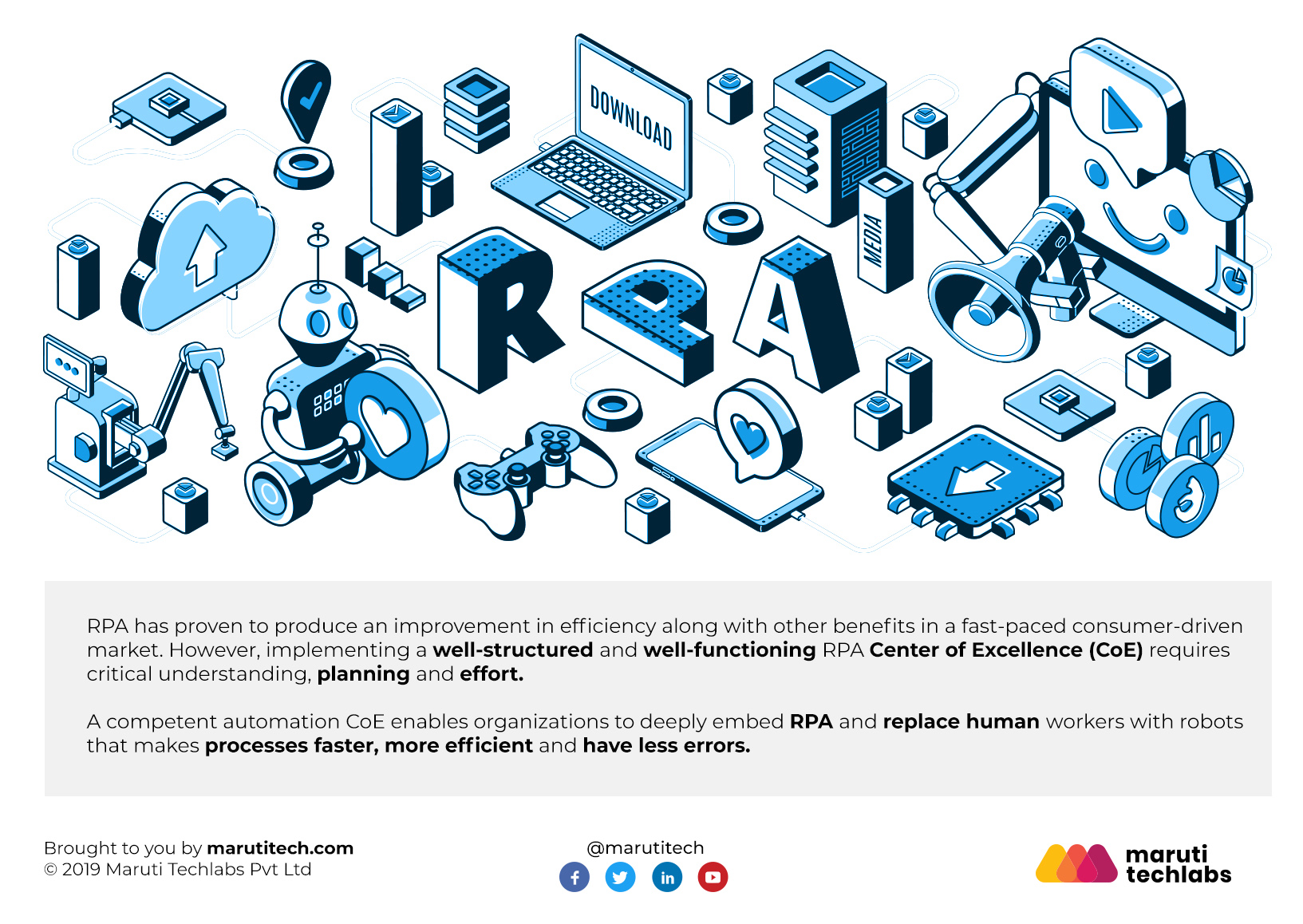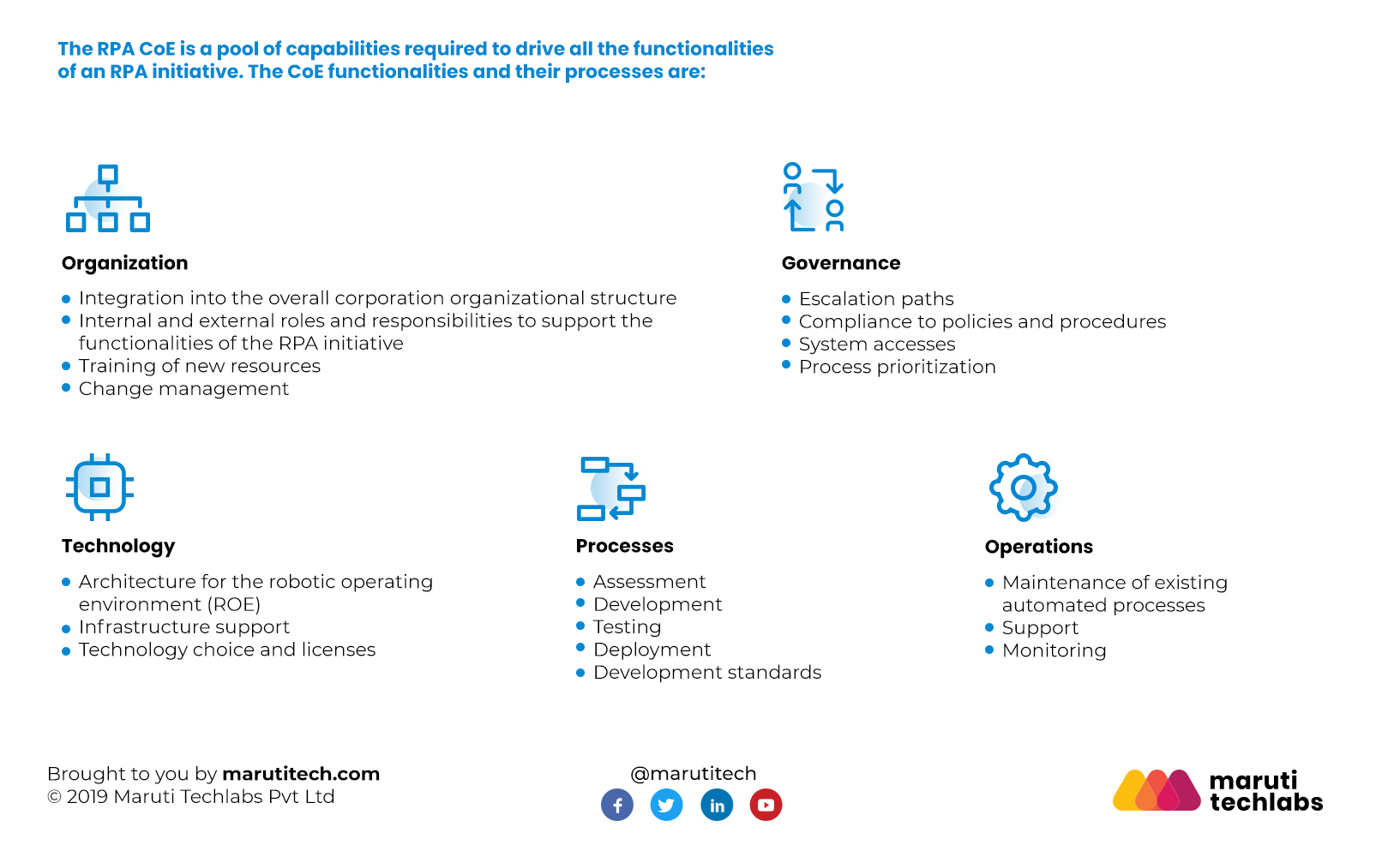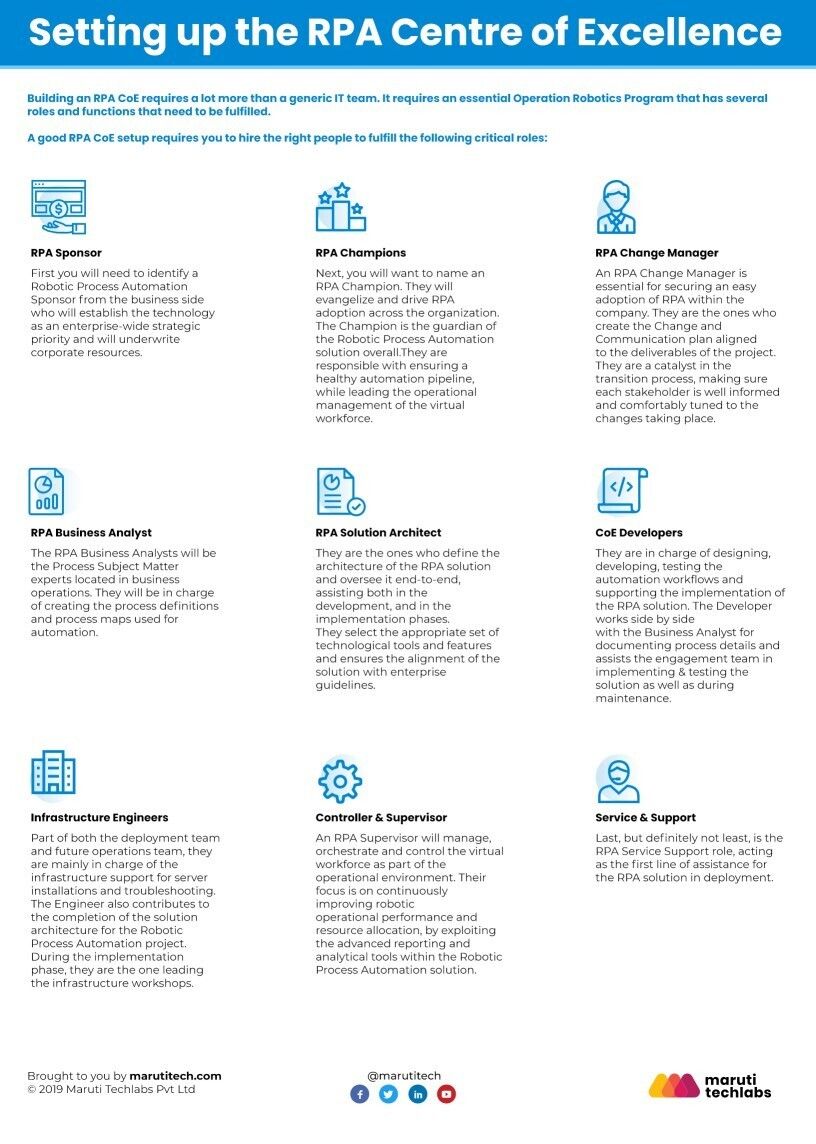

All You Need to Know About Building Your Effective RPA CoE






Thousands of companies from around the world are turning to robotic process automation (RPA) to make sure that their business operations are more productive, have fewer errors, and increase data security. Primarily, RPA is implemented for organizations to evolve strategically in order to fulfill company goals and visions.
Before you can set up and deploy RPA across the organization, you need to consider many important factors, such as the infrastructure, end goals, resources, and the progress of the program. A well-implemented RPA CoE setup can drive digital transformation and innovation.
According to a recent study by Horses for Source, only 18% of enterprises have set up a dedicated CoE model for RPA implementation. Almost 88% of these enterprises mentioned that having an automation CoE in place, is effective in delivering business value.

RPA has proven to produce an improvement in efficiency along with other benefits in a fast-paced consumer-driven market. However, implementing a well-structured and well-functioning RPA Center of Excellence (CoE) requires critical understanding, planning, and effort.
A competent automation CoE enables organizations to deeply embed RPA and replace human workers with robots that make processes faster, more efficient, and have fewer errors.
An RPA CoE allows businesses to automate the mundane tasks that human workers are often burdened with. While a human workforce is still necessary to create strategies and govern the business, their necessity in performing repetitive daily tasks will be massively reduced.
An effective RPA CoE is ideally meant to provide critical services through a high-performing operation model. This model will include the following elements:

A strong organizational core ensures that RPA is integrated throughout the company. It dictates the internal and external roles and responsibilities which support all the aspects of an RPA initiative. Simply put, this element defines the organizational structure of the CoE. Apart from the above, it is also responsible for acquiring and training new resources and seamless change management.
This element establishes clear robotic process automation standards, procedures, and policies along with governing bodies, escalation paths, and segregation of duties. It also ensures that compliance regulations, information security requirements, and regulatory standards are met. This element will also decide task prioritization and the level of access provided to different teams or employees employing the concepts of identity server for user management.
A good RPA CoE setup will be able to choose the right automation tools for appropriate tasks and also take care of the maintenance and support aspects of these tools. Essentially, it acts as the architect of the robotic operating environment. It will also boost RPA integration into crucial areas such as the IT Service Management and the Configuration Management Database.
Essentially, the home of RPA, this element executes, monitors, and alters the complete life cycle throughout the organization. It is in charge of evaluating automation opportunities, deploying RPA into suitable environments with a stable, scalable support structure. The assessment, development, testing, and deployment are all part of this element. Change processes and incident management also fall under this category.
With the successful implementation of RPA, there are structural changes within the organization. This element analyzes the effects of the RPA on human roles, from changing job descriptions to overall operational change management. It also takes into account the changes in organizational structure, monitors the RPA, and provides support when needed.

Building an RPA CoE requires a lot more than a generic IT team. It requires an essential Operation Robotics Program that has several roles and functions that need to be fulfilled. A good RPA CoE setup requires you to hire the right people to fulfill the following critical tasks:
Before implementing an RPA CoE, it is crucial to assess the technical feasibility of the automation you want to introduce so that its enterprise-wide adoption is smooth and effective. While identifying potential opportunities for RPA CoE setup, certain principles have to be kept in mind:
Now that the basic principles of RPA CoE have been noted, you need to decide on the scale, capabilities, and options for implementing the CoE. Your organization can deploy a CoE in various levels:
Now that we have covered the fundamental aspects of an RPA CoE setup along with principles, roles, and different models, let us take a look at some of the crucial factors in the building process.
If you want your RPA CoE to be an actual driver of innovation and digital transformation, then adequate planning is critical. Implementing RPA throughout an organization could lead to profound structural changes. However, prosperous businesses must remember that these employees have valuable experience and expertise at their disposal. As such, there should be a plan to reassign employee tasks or departments rather than letting them go.
Planning for structural changes allows you to differentiate between the tasks that are to be performed by a human workforce and tasks that are to be completed by automation. It also includes a clear communication strategy to clear employees’ worries and fuel innovation. The plan must also include a full description of where the digital workforce will operate such that employees know how and when to use it.
While many businesses might want to implement an RPA CoE set up, they do not know where and how to start. Questions about various factors like infrastructure, vendors, processes, documentation, and other considerations will likely be floating around.
The solution to these questions is to use a guide, either a consultant or an external firm, to help you explore and understand an automation CoE. A guide will make it easier to understand how a CoE will work within an organization.
Another significant consideration is whether your business should host the digital workforce on local data servers or on the cloud. While large, well-established companies might have the resources to host the RPA CoE at local data centers while other companies would prefer to host it on the cloud.
Both options have their benefits and drawbacks, which is why many companies choose to use a hybrid model that is customized to suit their needs. The hybrid option could have some digital workers operating from local data centers while others operate in the cloud.
The digital workforce’s success can be measured through various metrics other than just merely settling for cost reduction. Determining success metrics early in the RPA program is crucial for successful companies.
Cost reduction, increased efficiency, and accuracy are some of the most apparent success metrics but, depending on what the automation CoE is being used for, several other factors will be involved. These could include innovation, customer satisfaction, scaling, and more.
Once the above considerations are made, we can start setting up the RPA CoE. This procedure involves a lot of complicated processes, so we have provided some pointers to keep in mind:
When setting up and implementing an automation CoE, it is crucial to have the big picture in mind, but take small steps. A small start will help you understand the technology so you can then decide the organizational changes needed, where automation can be used, costs, and necessary tweaks or adjustments.
Thinking big is still as important as businesses that view automation CoE as just another tool often fail to reap its real benefits. Looking at the big picture helps empower employees to innovate and makes them eager to work with their digital counterparts. It also helps in planning future scaling.
Human workers and digital workers can both complete transactional workflow tasks, but only the first can use their creativity and intuition to grow the business. Setting up a CoE that encourages employees to create rather than stagnate is vital to a successful program.
A functional automation CoE setup frees up human time spent on routine tasks, allowing ground-level employees to innovate while subject matter experts can further use automation to help their creative endeavors.
Since hiring trends have changed drastically in favor of the employee, selecting the right people and technology has become more significant. Setting up an automation CoE that can handle the important yet transactional tasks can allow organizations to then hire employees who bring a multitude of skills and ideas with them.
An RPA CoE that does not allow you to better your service towards customers or clients is not fulfilling its potential. With the right automation CoE tools and implementation, a business can open up new opportunities to interact with customers, gain more potential leads and close more deals.
Investing in customer experience is essential, and a CoE must be used in a way that simplifies processes and makes them faster. Customer service related tasks, which used to take days to complete, can be fast-tracked while employees can also have more personal interactions with customers.
Your business’ needs will change as it grows, and your CoE should be equipped to evolve with it. A complete RPA CoE setup can make scaling easier as you can initialize more machines or software to do the work in a shorter time compared to the long hours it takes to hire and train new employees.
Essentially, adding more digital “clones” to the workforce is a lot easier than integrating new people into it, but this only works if the CoE has the capabilities to handle the demand.
An RPA CoE has a wide range of benefits that can vastly improve a business capabilities but building an automation CoE that matches your goals perfectly is no easy task. Implementing the CoE throughout the organization also requires a significant effort.
At Maruti Techlabs, we are highly experienced in constructing RPA CoE setups that perfectly suit your business and deploying automation for numerous industries. We've successfully implemented RPA in telecom and transformed end-to-end processes like customer onboarding, billing, and network management. Feel free to write to us at hello@marutitech.com or connect with us over a FREE 30-minute consultation call with our RPA consultants and engineers.


